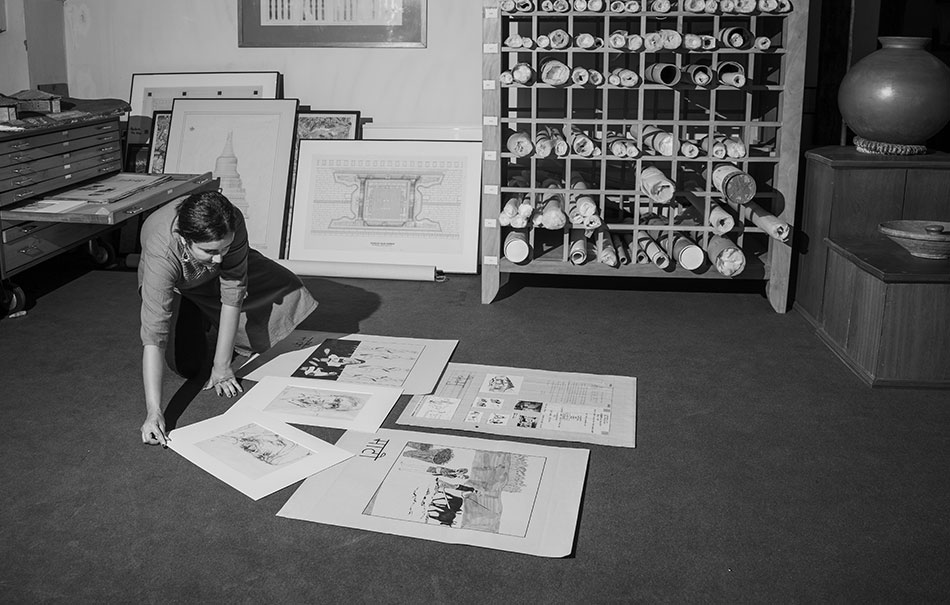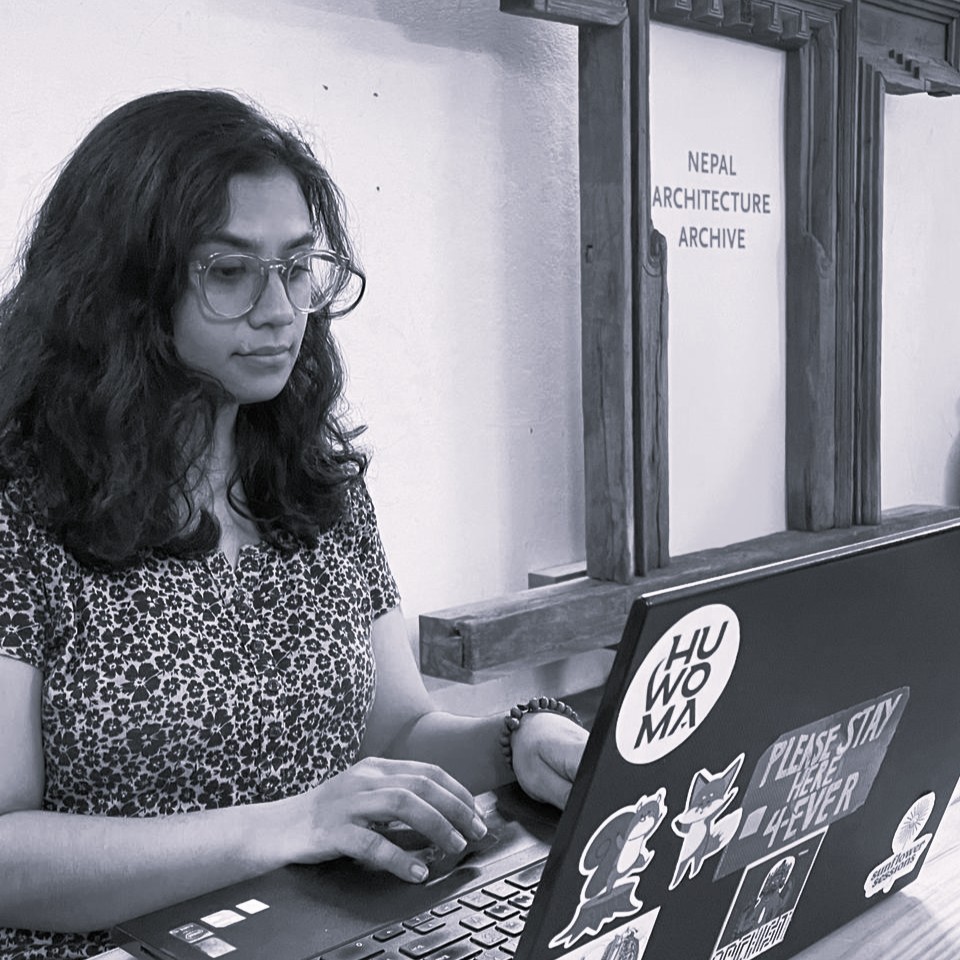

I've been working as an archivist at NAA for the past six months, and honestly, it has been quite a ride (I commute 45-60 minutes on a scooter every day). I still remember my first day I walked into the NAA space for an interview. And after a few weeks, I received my first architectural drawing to unpack. I think it was of Mustang. My jaw dropped. Getting an opportunity to touch and take care of architectural drawings that shaped and restored Nepal’s monumental and cultural history feels surreal. I mean, who gets to touch the original drawings of such a significant built-heritage every other week? I feel so lucky!
Since then, every time I unroll a new collection, it feels like opening a time capsule. Temples, monasteries, durbars, manuscripts from contributing scholars, you name it. I get a little too gaga, like a kid unwrapping presents. Once, while unpacking a temple drawing, possibly from Patan, I became so emotional that I actually bowed to it. Yep, full namaste mode. If my co-workers from Taragaon Next had been around, they might have thought I’d lost it, but I was just overwhelmed with gratitude. For me, this work is not just an archival care, but it feels more like a sacred responsibility.
As an introvert, this job is quite perfect for me. I can quietly focus on my work while surrounded by art and history. The only downside? Sunlight—Vitamin D deficiency is real, and I think archivists worldwide might secretly be half vampire and half human. To that, add the occasional power cut, which lasts about 10 seconds. During those moments, the space goes completely dark, making you feel like you've been dropped into an old dungeon. Here’s some practical advice: don’t dwell too much on mythological stories while researching on architectural drawings or other archival items. Believe me, those 10 seconds of darkness can feel like an audition for a horror movie. Still, the mythological stories and narratives are so entertaining that you can’t help yourself but read. So read and get scared!
Now, aside from my moments of awe and occasional panic in the dark, here’s what I’ve actually been doing. I’ve been helping to set up a digital database called Collective Access that records details of all the archival items and contributing scholars we have in the collection so far. Soon, the public will be able to browse our collections online. The same goes for the NAA library records. Everything used to be in Excel sheets, and now we’re building an online system so people can search and find what they need.
Besides my main job, I’m slowly moving into program design, events and workshops, and social media handling. It turns out that being an archivist isn’t just about handling delicate old papers; it’s also about learning an entirely new set of creative and technical skills. Each of these areas requires a different skill set, and I’m realizing how much there is to learn, not just as an archivist, but also as someone working in a creative, museum-like space. Some days I feel like an archivist and librarian; other days I feel like a content creator, and occasionally, a dungeon explorer and half vampire. Overall, it’s been magical, hilarious (especially when my colleagues from Taragaon Next are around), and humbling. I can’t wait to see how much more I’ll learn and how many more times I’ll embarrass myself by going full on namaste mode and fan-girling over heritage drawings.

I joined NAA as an archivist and researcher in mid-July 2022. The initial days involved immersing myself in the archive’s collection and understanding them. It took me a couple of months to grasp their essence and begin the actual work.
I remember the first time I entered the archive; the space completely mesmerized me. I had always imagined working around books and objects from the past. However, the requirements were completely different than what I had thought. In my second month, I was handed my first drawing roll to create an unpacking list. I was utterly clueless about the architectural drawings I was dealing with. I had neither an architectural nor an archival background. What I found more perplexing was logging the details into an Excel sheet, something I had never done before. Fortunately, I was a quick learner and found my way around without embarrassing myself. Reflecting on the simplest things I found challenging back then is both hilarious and helpful, as it illuminates how far I have come today.
While working for NAA, I gained experience as an archivist, researcher, and content writer. In addition to my regular tasks such as managing the archive's space, taking care of the collection, creating records and inventories, communicating with the scholars associated with the archive, writing their biographies, documenting the work procedures, and creating content for social media profile, I also had the opportunity to interview the scholars, anchor in the museum events, organize an archival program (The Gossip Table #1), build the archive's website, and even draft a long-term plan for the archive.
NAA helped me realize the wealth of knowledge our collection holds and the impact it can have in the community, ultimately molding me into a curator as well. “The Heritage Buzz” was my first-ever official exhibition. It explored the scope of documentation in terms of materials and delved into the heritage projects in Kathmandu Valley since the late 1960s that created a buzz in media and culture, influencing our perspective towards our cultural and architectural heritage. I spent almost a year on its research, with the first half progressing relatively slowly but picking up a quality pace in the later months. I was involved in every step of the process, from research and planning to production and the final exhibition. I meticulously handled the selection and scanning of materials, and engaged in writing texts, preparing exhibition design, installing the exhibits, promoting the exhibition and related programs on social platforms, and finally, documenting the entire process. This single project entirely changed my perspective of our heritage and history and inspired me to pursue this subject for further studies.
My time in the archive was a great learning experience, shaping me into a more patient, perseverant, thorough, organized, and committed professional. It opened my eyes to the boundless possibilities of working in the field of heritage. My two years in NAA were very inspiring and dynamic, and I will always cherish the opportunities and growth the space provided me as I move forward with my other aspirations in life.
An extract from my everyday journal at NAA:
“25 January 2023: I enjoy our archive’s space so much that I’m almost Vitamin D deficient.”

I graduated from the University of Texas at Austin with a master's degree in Historic Preservation. I volunteered at NAA for seven months, assisting archivist and conservationist Jerrine George. We assessed the materials' condition by carefully examining simple creases, tears, and discolorations. Together, we produced descriptions for the materials. I was also responsible for naming the materials, adding their accession numbers, creating boxes for storage, digitizing the extracted information, and updating the Excel sheets.
The NAA experience was exciting and insightful. I loved the workplace, my colleagues, and the collections. Whenever we explored a new set of works, I would stare at them in admiration. I learned a lot about the organization from Jerrine and gained firsthand experience with archives. The knowledge I gained through it has also helped me orient myself in the university. A recent tour to conservation labs with my university reminded me of my volunteer work at NAA, even though it was only a basic part of what I saw in the conservation lab here.
Archival materials are the primary source of information; they are of great value for historians, architects, and researchers. I can do extensive research work because of the advanced archives in the USA. NAA, too, has great potential to support and provide for architectural research.

I spent about a year working in NAA while simultaneously working as an in-house architect at Hyatt Regency Kathmandu. I was mostly involved in documenting historical drawings, which included properly studying and documenting individual drawings. I had a wonderful experience during that process, during which I learned about the historical architecture of Nepal in detail.
The knowledge I gained while working at NAA has helped me in my architecture practice. I am currently practicing in my own firm, which focuses on incorporating elements of local vernacular architecture to build sustainable and energy-efficient designs. We are mostly doing hospitality projects, including a few international projects in the US and India. After starting my own firm, my first project was a renovation project at a prestigious 5-star hotel. The learning at NAA helped me achieve construction details inspired by traditional architecture.
I enjoyed working with a wonderful team, which was probably my best time in Taragaon and NAA. Learning about historical architecture in depth, understanding all the details, and connecting to the past is the best experience an architect can have.
Documentation of historical drawings provides an understanding of our heritage. For the upcoming generation, it can be a vital tool to understand heritage buildings that might have been destroyed with time. With the involvement of each generation with NAA, architects can get more connected with the past.